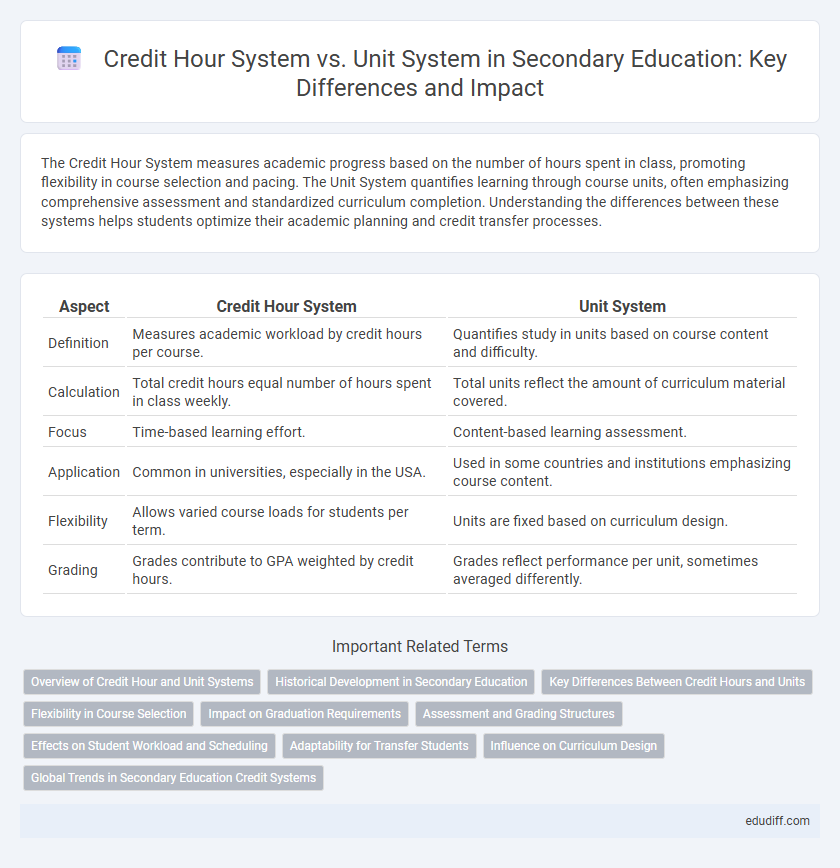The Credit Hour System measures academic progress based on the number of hours spent in class, promoting flexibility in course selection and pacing. The Unit System quantifies learning through course units, often emphasizing comprehensive assessment and standardized curriculum completion. Understanding the differences between these systems helps students optimize their academic planning and credit transfer processes.
Table of Comparison
| Aspect | Credit Hour System | Unit System |
|---|---|---|
| Definition | Measures academic workload by credit hours per course. | Quantifies study in units based on course content and difficulty. |
| Calculation | Total credit hours equal number of hours spent in class weekly. | Total units reflect the amount of curriculum material covered. |
| Focus | Time-based learning effort. | Content-based learning assessment. |
| Application | Common in universities, especially in the USA. | Used in some countries and institutions emphasizing course content. |
| Flexibility | Allows varied course loads for students per term. | Units are fixed based on curriculum design. |
| Grading | Grades contribute to GPA weighted by credit hours. | Grades reflect performance per unit, sometimes averaged differently. |
Overview of Credit Hour and Unit Systems
The Credit Hour system quantifies student workload based on the number of hours spent in direct instruction, typically equating one credit hour to one hour of classroom or contact time per week over a term. The Unit system measures academic progress by the completion of entire courses or modules, often assigning a fixed unit value to each regardless of contact hours. Both systems aim to standardize curriculum requirements, but they differ in emphasis on instructional time versus course completion metrics.
Historical Development in Secondary Education
The Credit Hour System in secondary education originated from early 20th-century American colleges, emphasizing standardized time-based learning measurement, while the Unit System developed in secondary schools to provide a flexible structure based on course content completion. Historically, the Unit System gained prominence in secondary education through progressive education reforms that prioritized mastery over seat time. Over time, many secondary institutions integrated both systems to balance curriculum standards with student learning pace and educational objectives.
Key Differences Between Credit Hours and Units
Credit hours measure the amount of time a student spends in class per week, typically representing one hour of lecture or two to three hours of lab work weekly over a semester. Units, on the other hand, often denote the total academic value assigned to a course, which may include lectures, labs, and other coursework components, varying by institution. The key difference lies in credit hours emphasizing contact time, while units reflect the overall workload and academic weight of a course.
Flexibility in Course Selection
The Credit Hour System offers greater flexibility in course selection by allowing students to accumulate a specified number of credits at their own pace, facilitating customized learning paths. In contrast, the Unit System often requires students to follow a fixed set of courses within a rigid structure, limiting elective choices and adaptability. This difference makes the Credit Hour System more accommodating for diverse academic goals and schedules.
Impact on Graduation Requirements
The Credit Hour System quantifies academic progress by allocating specific hours per course, directly influencing the total number of hours required for graduation. The Unit System, often based on curriculum-defined units, affects graduation by emphasizing course completion rather than time spent. Differences in these systems can alter students' workload distribution and degree completion timelines.
Assessment and Grading Structures
The Credit Hour System allocates credit based on the total instructional hours per week throughout a term, typically emphasizing continuous assessment and a cumulative grading structure that reflects student engagement and performance over time. In contrast, the Unit System assigns credits based on course content complexity and learning objectives, often employing a modular assessment approach with discrete grading components for each unit, facilitating targeted evaluation of specific competencies. Both systems influence GPA calculation methodologies, where the Credit Hour System usually integrates weighted averages of course grades, while the Unit System may adopt a more segmented grading scale aligned with individual unit mastery.
Effects on Student Workload and Scheduling
The Credit Hour System typically standardizes student workload by assigning a fixed number of hours per credit, facilitating predictable scheduling and workload management across semesters. In contrast, the Unit System may vary in workload intensity, requiring students to manage inconsistent study hours and complicating timetable organization. These differences significantly impact academic planning, with the Credit Hour System often providing clearer expectations for balancing coursework and extracurricular activities.
Adaptability for Transfer Students
The Credit Hour System offers greater adaptability for transfer students by standardizing course loads and facilitating easier evaluation of completed credits across institutions. In contrast, the Unit System's variability in credit assignments can complicate credit transfer and prolong degree completion. Institutions adopting the Credit Hour System often streamline academic transitions and improve credit recognition, enhancing transfer student success rates.
Influence on Curriculum Design
The Credit Hour System emphasizes time-based measurement, allocating specific hours to each course, which streamlines the design of curriculum by standardizing course loads and facilitating semester planning. In contrast, the Unit System focuses on course content complexity and learning outcomes, promoting flexible curriculum structures that prioritize depth over duration. This fundamental difference influences curriculum design by shaping how academic programs balance workload, assessment standards, and educational objectives.
Global Trends in Secondary Education Credit Systems
Global trends in secondary education reveal a growing preference for the credit hour system over the unit system, driven by its flexibility in accommodating diverse student learning paces and course selections. Countries adopting the credit hour system report improved student engagement and better alignment with higher education and labor market requirements. This shift supports personalized learning pathways, enabling students to accumulate credits based on competency rather than fixed time frames.
Credit Hour System vs Unit System Infographic

 edudiff.com
edudiff.com